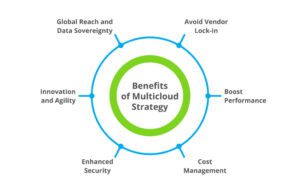
10 Tips for Calculating Business Value in a Multicloud World
In today’s rapidly evolving digital landscape, the multicloud world has emerged as a cornerstone for organizations aiming to achieve unparalleled flexibility, scalability, and resilience. As businesses increasingly rely on multiple cloud platforms to diversify their IT infrastructure, calculating the business value derived from these investments becomes both crucial and challenging. The multicloud approach allows organizations to leverage the strengths of various cloud providers while minimizing risks associated with vendor lock-in. However, the complexity of managing multiple platforms necessitates a strategic approach to accurately assess their impact on business outcomes. Here, we delve deeply into ten comprehensive tips to help you evaluate and maximize the business value of operating in a multicloud world.

- Define Clear Objectives Defining clear and actionable objectives is the cornerstone of any successful multicloud world. A multicloud world offers significant advantages, such as cost optimization, enhanced application availability, and compliance with regional data regulations. However, these benefits can only be realized if they align with specific business goals. For example, an organization aiming to improve customer satisfaction might focus on reducing application latency and enhancing uptime. By setting measurable goals like increased revenue, reduced operational costs, or improved customer satisfaction scores, businesses can establish a framework for evaluating the success of their multicloud world. These objectives should also be communicated across teams to ensure alignment and a shared vision.
- Understand Total Cost of Ownership (TCO) Calculating the Total Cost of Ownership (TCO) is fundamental to understanding the financial commitment involved in a multicloud environment. TCO encompasses both direct and indirect costs, including subscription fees, licensing, migration expenses, and ongoing maintenance. For example, while migrating to a multicloud setup might involve initial investments in training personnel and reconfiguring applications, these costs can be offset by long-term savings from optimized resource utilization. Tools such as AWS TCO Calculator and Azure Pricing Calculator can help break down these costs, providing a detailed view of the financial landscape. Accurately calculating TCO allows businesses to make informed decisions about resource allocation and assess whether their multicloud world delivers value proportional to its costs.
- Establish Key Performance Indicators (KPIs) Key Performance Indicators (KPIs) are critical for measuring the performance of a multicloud strategy. These metrics should align with the organization’s objectives and provide insights into essential factors such as application uptime, response times, and user satisfaction. For instance, a KPI might track the percentage of time applications remain available to users or the average response time during peak usage periods. Regularly monitoring these KPIs allows businesses to identify trends, evaluate progress, and make data-driven decisions to optimize their multicloud setup. Comparing these metrics to industry standards or pre-implementation baselines provides a clear picture of the improvements achieved.
- Leverage Cloud-Native Monitoring Tools The complexity of managing multiple cloud platforms necessitates the use of cloud-native monitoring tools. These tools, such as Google Cloud’s Operations Suite or Datadog, offer centralized dashboards that consolidate data from various providers, providing a unified view of the multicloud environment. Effective monitoring ensures seamless performance, identifies bottlenecks, and enables proactive issue resolution. For example, a retail company might use these tools to monitor server usage during high-demand periods, ensuring that resources are appropriately scaled to prevent downtime. By leveraging these capabilities, businesses can maintain consistent performance and reliability, which are vital components of business value in a multicloud world.
- Evaluate Flexibility and Scalability One of the primary benefits of a multicloud strategy is the ability to scale resources based on demand and adapt quickly to changing business needs. Evaluating the flexibility and scalability of a multicloud setup involves analyzing metrics such as the time required to deploy new applications or scale existing ones. For instance, during a product launch, a business can measure how quickly additional server capacity is provisioned to handle increased traffic. This agility not only supports rapid innovation but also reduces costs associated with over-provisioning. Quantifying these benefits demonstrates the strategic value of a multicloud approach in driving operational efficiency and responsiveness.
- Quantify Risk Mitigation and Compliance Benefits Risk mitigation and regulatory compliance are critical aspects of operating in a multicloud environment. By distributing workloads across multiple platforms, businesses can reduce the risk of downtime caused by provider-specific outages and ensure data redundancy. Additionally, multicloud strategies often enable compliance with regional data regulations by allowing data storage in specific geographic locations. For example, a healthcare organization might use multicloud to store patient data in compliance with GDPR while ensuring high availability. Assigning a monetary value to these benefits, such as revenue saved during prevented outages or fines avoided through compliance, provides a tangible measure of the value delivered by the multicloud setup.
- Measure Innovation Outcomes Multicloud platforms provide access to advanced technologies such as artificial intelligence (AI), machine learning (ML), and the Internet of Things (IoT), enabling businesses to innovate and differentiate themselves in competitive markets. Measuring innovation outcomes involves evaluating how these capabilities drive new revenue streams, enhance operational processes, or improve customer experiences. For instance, a manufacturing company might use IoT-enabled sensors on a multicloud platform to optimize production lines, reducing downtime and costs. Tracking the number of innovation-driven projects, revenue generated from new offerings, and competitive advantages gained helps quantify the strategic value of multicloud in fostering innovation.
- Assess Operational Efficiency Operational efficiency is often a by product of adopting a multicloud strategy. By automating routine tasks, optimizing workload distribution, and streamlining workflows, businesses can achieve significant time and cost savings. For example, automating resource provisioning can reduce the time IT teams spend on manual tasks, freeing them to focus on strategic initiatives. Comparing pre- and post-multicloud operational metrics provides a clear picture of the efficiency gains achieved. These improvements not only reduce costs but also enhance the organization’s ability to respond to market demands, underscoring the value of a well-implemented multicloud strategy.
- Evaluate Employee Productivity Multicloud environments facilitate seamless access to tools, data, and applications, boosting employee productivity and collaboration. For example, a global team working on a multicloud platform can access shared resources without latency, enabling faster decision-making and project completion. Measuring productivity gains involves tracking time saved in workflows, improved collaboration metrics, and employee satisfaction scores. Employee feedback through surveys or performance reviews can provide qualitative insights into how multicloud systems impact day-to-day operations. These improvements translate into better business outcomes, reinforcing the value of investing in a multicloud strategy.
- Calculate Return on Investment (ROI) Calculating the Return on Investment (ROI) provides a comprehensive view of the value delivered by a multicloud strategy. ROI analysis involves comparing the benefits realized—such as cost savings, revenue growth, and intangible advantages like improved brand reputation—against the total costs incurred. For instance, a retail company might calculate the increased revenue from reduced cart abandonment due to improved website performance on a multicloud platform. Using structured frameworks, such as Gartner’s ROI model for cloud computing, ensures a holistic evaluation. A robust ROI calculation not only demonstrates the financial impact of multicloud investments but also strengthens the business case for continued adoption and optimization.
Benefits of a Multicloud Strategy
Adopting a multicloud approach offers several advantages:
- Flexibility: Choose the best providers for specific tasks.
- Resilience: Reduce dependency on a single provider, minimizing risks.
- Cost Optimization: Tailor resource allocation to fit budgetary constraints.
- Global Reach: Expand operations seamlessly with geographically distributed clouds.
Applications of Multicloud in Real Life
- Netflix: Leverages multiple clouds to deliver uninterrupted streaming across the globe.
- Airbnb: Uses multicloud to ensure reliable services for users in different regions.
- GE: Employs multicloud for data-intensive operations and IoT applications.
Future Trends in the Multicloud World
The future of multicloud is dynamic, with innovations shaping its trajectory:
- AI and ML Integration: Automation and predictive analytics will streamline operations.
- Enhanced Security Protocols: Unified frameworks to combat evolving cyber threats.
- Sustainability Initiatives: Energy-efficient cloud solutions to reduce carbon footprints.
Conclusion:
In conclusion, the multicloud world offers unparalleled opportunities for businesses to innovate, scale, and thrive in an increasingly competitive environment. By following these ten tips, organizations can effectively calculate and maximize the business value of their multicloud strategies. From defining clear objectives and understanding costs to leveraging advanced technologies and fostering innovation, a systematic approach ensures that multicloud investments deliver measurable and sustainable benefits. As businesses navigate the complexities of the multicloud world, adopting these strategies will transform their IT infrastructure into a powerful driver of growth and success.


